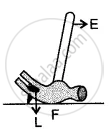Advertisements
Advertisements
प्रश्न
In the diagram shown alongside a claw hammer, mark the fulcrum (F) and indicate the directions of load (L) and effort (E) with arrows. What class of lever is it? Give one more example of this class of lever.

उत्तर
Claw-hammer is the lever of the first order. One more example of this class of lever is a see-saw. In the following diagram, F indicates the position of the fulcrum. The arrows labelled L and E respectively indicate the directions of load and effort.
APPEARS IN
संबंधित प्रश्न
The diagram below shows a lever in use:

- To which class of levers does it belong?
- Without changing the dimensions of the lever, if the load is shifted towards the fulcrum what happens to the mechanical advantage of the lever?
Draw a diagram of a lever which is always used as a force multiplier. How is the effort arm related to the load arm in such a lever?
Class II levers are designed to have ______.
A man uses a crowbar of length 1.5 m to raise a load of 75 kgf by putting a sharp edge below the bar at a distance 1 m from his hand.
- Draw a diagram of the arrangement showing the fulcrum (F), load (L) and effort (E) with their directions.
- State the kind of lever.
- Calculate:
- load arm,
- effort arm,
- mechanical advantage and
- the effort needed.
Fig 3.17 below shows a lever in use.

(a) To which class of lever does it belong?
(b) If FA = 80 cm, AB = 20 cm, find its mechanical advantage.
(c) Calculate the value of E.
The following belong to which class of lever?
Human-arm
The following belong to which class of lever?
Nutcracker
The following belong to which class of lever?
Knife
What is a first-order lever?
A lever is used to multiply the force.
